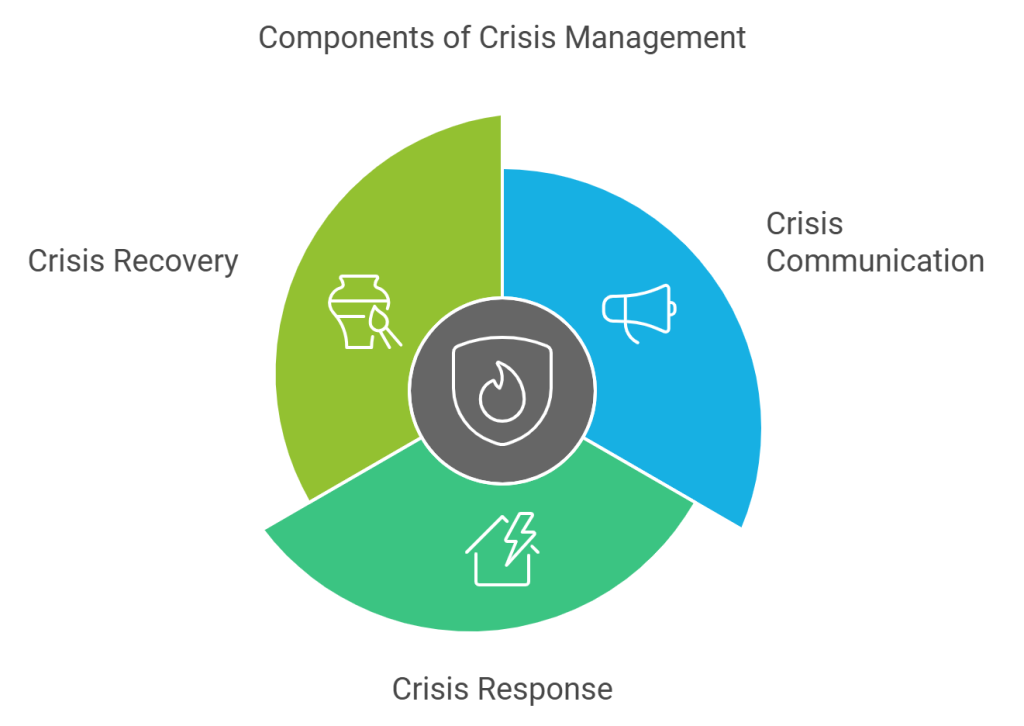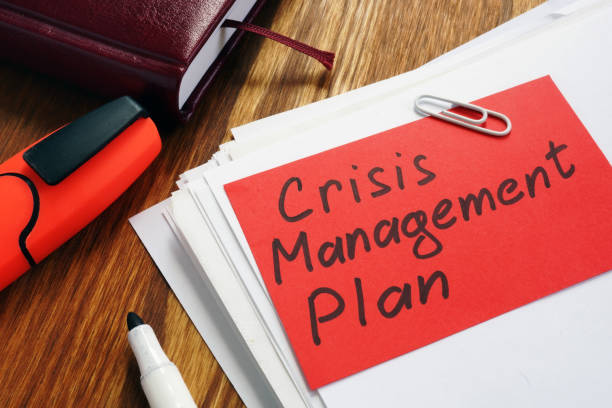Crisis and Crisis Management Definition
A crisis is a sudden, unexpected event that threatens an organization’s ability to function, reputation, or financial stability. Moreover, crisis management is the systematic process of planning, organizing, leading, and controlling resources to mitigate the impact of a crisis and restore normal operations.
Key Components of Crisis Management
- Crisis Communication: Effective communication with stakeholders, including employees, customers, and the public.
- Crisis Response: Swift and decisive action to address the crisis and minimize damage.
- Crisis Recovery: Restoring operations, rebuilding reputation, and learning from the experience.

Specific Crisis Types Summary
Crises can arise from a variety of sources and can significantly impact organizations. Here are some common types of crises:
Natural Disasters
- Earthquakes: Can cause significant damage to infrastructure and disrupt operations.
- Floods: Can lead to property damage, supply chain disruptions, and employee displacement.
- Hurricanes: Can cause widespread damage, power outages, and transportation disruptions.
- Wildfires: Can damage property, disrupt operations, and pose health risks to employees.
Human-Caused Disasters
- Accidents: Can result from equipment failure, human error, or other unforeseen circumstances.
- Workplace Violence: Can involve physical or verbal aggression, threats, or harassment.
- Data Breaches: Can lead to loss of sensitive information, reputational damage, and legal liabilities.
- Product Recalls: Can damage brand reputation and lead to financial losses.
Organizational Crises
- Financial Crises: Can arise from economic downturns, mismanagement, or fraudulent activities.
- Leadership Crises: Can occur due to leadership failures, scandals, or ethical breaches.
- Public Relations Crises: Can arise from negative publicity, social media backlash, or public perception issues.
Navigating Workplace Violence: An HR Guide to Prevention and Response
Workplace violence, a distressing reality, can have far-reaching consequences for individuals, organizations, and communities. While it’s impossible to eliminate all risks, HR professionals can play a pivotal role in preventing and responding to such incidents. This comprehensive guide delves into the key strategies HR can implement to safeguard the workplace.
Understanding the Spectrum of Workplace Violence
Workplace violence can manifest in various forms, including:
- Physical Violence: Acts of physical aggression, such as assault or homicide.
- Verbal Abuse: Threats, intimidation, or harassment.
- Cyberbullying: Online harassment or threats.
The HR Role in Proactive Workplace Violence Prevention
- Develop a Robust Workplace Violence Prevention Policy:
- Clearly define what constitutes workplace violence.
- Establish comprehensive procedures for reporting incidents.
- Outline protocols for thorough investigation and appropriate response.
- Implement a zero-tolerance policy for violent behavior.
- Invest in Regular Training and Education:
- Train employees to recognize and respond to potential signs of violence.
- Equip employees with de-escalation techniques and conflict resolution strategies.
- Empower managers to address concerns and intervene effectively.
- Implement Rigorous Screening Processes:
- Conduct thorough background checks for all new hires.
- Screen job applicants for a history of violence or other concerning behaviors.
- Cultivate a Positive and Supportive Workplace Culture:
- Foster open communication channels and a respectful work environment.
- Encourage employees to report concerns or incidents without fear of retaliation.
- Provide comprehensive employee assistance programs (EAPs) to support mental health and well-being.
Responding Effectively to a Workplace Violence Incident
- Prioritize Employee Safety:
- Immediately prioritize the safety of employees and other individuals on-site.
- Implement emergency procedures, such as lockdowns or evacuations.
- Cooperate fully with law enforcement to secure the scene.
- Activate a Crisis Response Team:
- Convene a dedicated crisis response team, including HR, legal, and security representatives.
- Establish clear communication channels and assign specific roles and responsibilities.
- Provide Comprehensive Support to Victims:
- Offer immediate support and counseling to victims and witnesses.
- Connect them with appropriate resources, such as medical care and legal assistance.
- Ensure their privacy and confidentiality are protected.
- Conduct a Thorough and Impartial Investigation:
- Gather evidence meticulously and interview witnesses objectively.
- Document the incident comprehensively and take appropriate disciplinary action against the perpetrator.
- Review existing security protocols and identify areas for improvement.
Post-Incident Recovery and Enhanced Prevention
- Communicate Openly and Empathetically:
- Provide timely, honest, and transparent updates to employees about the incident and its aftermath.
- Address rumors and misinformation proactively.
- Reassure employees that the organization is committed to preventing future incidents.
- Review and Refine Policies and Procedures:
- Evaluate the effectiveness of existing policies and procedures rigorously.
- Make necessary changes to enhance security and safety.
- Consider implementing additional measures, such as security cameras or access control systems.
- Promote Mental Health and Well-being:
- Offer ongoing counseling and support services to employees.
- Encourage open communication and stress management techniques.
- Create a supportive and empathetic work environment.
By adopting a proactive approach to workplace violence prevention and response, HR professionals can significantly contribute to creating safer and more secure workplaces. Remember, the ultimate goal is not only to react to incidents but to prevent them from occurring in the first place


